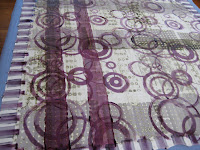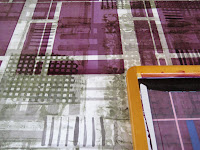 |
| Sedum in the snow at the Crane |
About a month later we had a big blizzard and I had been reading about snow dyeing on the web and so had my opportunity to experiment. I experimented with a range of different silks and was quite taken with many of the pieces, but several were disappointing. I know that many quilters use their snow dyed cottons cut up in their quilts... but I am not a quilter. However, as I was applying for membership to THE ARTCLOTH NETWORK and these were the right size for artcloth and so I decided to have a go at it.
 |
| Fiber reactive snow dyed 15mm Habotai |
I was only mildly interested in the results that I got on the 15mm Habotai. There was not enough contrast to hold my interest, so after washing and drying I soda soaked it again, let it dry and stretched it on my print table. I didn't photograph my steps, but I will show you details from the finished piece that illustrate them.
 |
| detail of deconstructed silk screen |
I made a deconstructed silk screen using deep red and released it using a pale golden beige color. I love deconstructed printing as you never really know what you will get and it sets my imagination free. Also my work habits are much more intuitive than pre-planned so it suits me.
 |
| discharged and painted with MX |
If you look in the lower left hand corner of this detail you can see that I also drew on it with Jaquard discharge paste... from a squeeze bottle.
 |
| Sedum 91"x53" |
So I am not sure if even I see the reference to the original Sedum in the snow image... but that was the thought process. Of course the only snow reference in this artcloth is that it was snow dyed. It is 91"x53" and was part of my successful submission for membership in Artcloth Network.


















